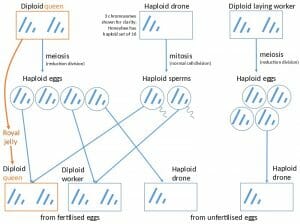Haploid Definition
Haploid is the condition of a cell having a one set of chromosomes. Ploidy refers to the number of copies of the genome. Humans, and many other organisms, are diploid organisms. This means that the majority of their lifecycle is spent with two copies of the genome in every cell. Typically, haploid cells are created for reproductive purposes. By reducing the genome to one copy, different copies can be rearranged when creating a zygote. By reducing the DNA material in the gametes to haploid, many new combinations are possible within the offspring. This increases the genetic variation and helps populations adapt to their environment.
Examples of Haploid
Haploid Cells in Humans
For the entirety of your life, the cells in your body are diploid, with a few exceptions. Your mother and father produced gametes, haploid cells, which came together to produce the first cell of your body. This single celled zygote replicated both copies of DNA before dividing into two identical daughter cells. The cells continued replicating and dividing until they formed a small ball, the blastula, which began folding and differentiating into various body parts. The cells in your body will remain diploid, as they continue replicating through mitosis. However, your reproductive organs will serve a special purpose. Instead of copying themselves through mitosis, certain parts of the tissues will undergo meiosis. Unlike mitosis, meiosis divides the homologous chromosomes and reduces the ploidy of the daughter cells created. These special gametes, eggs and sperm, are now the only haploid cells in your body. They are prepped to find a gamete of the opposite sex and produce a new zygote.
Haploid Drones in Insects
Many species of insect have a special sex determination system, which relies on the ploidy of the individual involved. Check out the diagram below, representing breeding systems in many bees and ants. The queen can be found in the upper-left. The queen, and all the worker bees are diploid organisms. These bees do the majority of the work in the colony, including gathering food, rearing the young, and disposing of the dead.
To the right of the queen is the haploid drone. This male insect has one simple job: carry sperm to other colonies. The queens of each colony use this sperm to fertilize their eggs, which are also haploid. Combining two haploid cells creates a diploid cell. Typically, these diploid larvae develop into average worker bees. However, if fed “royal jelly” the worker will develop into a queen. The special food activates various pathways which make the worker larger and allow her to lay eggs. Once a hive is established, the old queen will give birth to a successor and leave the hive with many of the workers to establish a new hive. The new queen must wait to be fertilized by a haploid drone before laying new workers.
Quiz
1. True or False. A haploid cell cannot undergo mitosis.
A. True
B. False
References
- Hartwell, L. H., Hood, L., Goldberg, M. L., Reynolds, A. E., & Silver, L. M. (2011). Genetics: From Genes to Genomes. Boston: McGraw Hill.
- McMahon, M. J., Kofranek, A. M., & Rubatzky, V. E. (2011). Plant Science: Growth, Development, and Utilization of Cultivated Plants (5th ed.). Boston: Prentince Hall.
Haploid

No comments:
Post a Comment